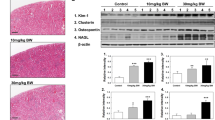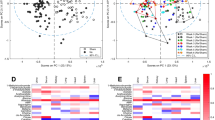Abstract
Melamine-induced renal toxicity is associated with crystal formation in the kidney following exposure to melamine and cyanuric acid. However, metabolomic profiling of intact kidney tissue after chronic intake of melamine and cyanuric acid (M + CA) mixtures has rarely been studied. The present study investigated the melamine-induced renal toxicity by determining metabolites in the kidney through [1H]nuclear magnetic resonance. Melamine (63 mg/kg) and cyanuric acid (6.3 mg/kg) were co-administered to rats via oral gavage for 30 days. The mixture of M + CA (63/6.3 mg/kg) induced nephrotoxicity, as determined by increased blood urea nitrogen (BUN) and creatinine levels. The kidney weights were significantly increased in the animals treated with M + CA (63/6.3 mg/kg). The histological analysis revealed epithelial degeneration and necrotic cell death in the proximal and distal tubules. Furthermore, various metabolites were altered in both renal medullar and cortical tissues. In the medullar tissues, asparagine, choline, creatinine, cysteine, ethanolamine, glucose, isoleucine, glutamine, and myo-inositol levels were elevated, but glucitol, phenylalanine, tyrosine, and sn-glycero-3-levels were reduced. In the cortex, ethanolamine, hypoxanthine, isoleucine and o-phosphoethanolamine levels were increased, whereas formate, glucose, glutathione, threonine, and myo-inositol levels were decreased, suggesting the M + CA-induced renal cell injury. These data suggest that a mixture of M + CA-induced metabolites may be useful biomarkers for the detection of kidney injury.





Similar content being viewed by others
References
Aranibar N, Borys M, Mackin NA, Ly V, Abu-Absi N, Abu-Absi S, Niemitz M, Schilling B, Li ZJ, Brock B, Russell RJ 2nd, Tymiak A, Reily MD (2011) NMR-based metabolomics of mammalian cell and tissue cultures. J Biomol NMR 49:195–206
Baynes RE, Smith G, Mason SE, Barrett E, Barlow BM, Riviere JE (2008) Pharmacokinetics of melamine in pigs following intravenous administration. Food Chem Toxicol 46:1196–1200
Bhat VS, Ball GL, McLellan CJ (2010) Derivation of a melamine oral reference dose (RfD) and drinking-water total allowable concentration. J Toxicol Environ Health Part Crit Rev 13:16–50
Brown CA, Jeong KS, Poppenga RH, Puschner B, Miller DM, Ellis AE, Kang KI, Sum S, Cistola AM, Brown SA (2007) Outbreaks of renal failure associated with melamine and cyanuric acid in dogs and cats in 2004 and 2007. J Vet Diagn Invest 19:525–531
Coen M (2010) A metabonomic approach for mechanistic exploration of pre-clinical toxicology. Toxicology 278:326–340
Dalal RP, Goldfarb DS (2011) Melamine-related kidney stones and renal toxicity. Nat Rev Nephrol 7:267–274
Gossner CM, Schlundt J, Ben Embarek P, Hird S, Lo-Fo-Wong D, Beltran JJ, Teoh KN, Tritscher A (2009) The melamine incident: implications for international food and feed safety. Environ Health Perspect 117:1803–1808
Guan N, Fan Q, Ding J, Zhao Y, Lu J, Ai Y, Xu G, Zhu S, Yao C, Jiang L, Miao J, Zhang H, Zhao D, Liu X, Yao Y (2009) Melamine-contaminated powdered formula and urolithiasis in young children. N Engl J Med 360:1067–1074
Hazardous Substances Data Bank (2008) Cyanuric acid. HSDB Number: 2818. Hazardous Substances Data Bank. National Toxicology Information Program, US National Library of Medicine, Bethesda, USA. http://toxnet.nlm.nih.gov/cgibin/sis/htmlgen?HSDB
Health Canada (2008) Health Canada’s human health risk assessment supporting standard development for melamine in foods. Ottawa, Ontario, Health Canada, Health Products and Food Branch, Food Directorate, Bureau of Chemical Safety. http://www.hc-sc.gc.ca/fn-an/alt_formats/hpfb-dgpsa/pdf/pubs/melamine_hra-erseng.pdf
Holmes EW, Kinzler GJ, Flanigan RC, Bermes EW Jr (1991) Free amino acids during chronic cyclosporine A toxicity in intact and partially nephrectomized rats. Exp Mol Pathol 55:83–96
Hung BP (2008) China’s tainted infant formula: what WHO should do. BMJ 13:337
Jacob CC, Reimschuessel R, Von Tungeln LS, Olson GR, Warbritton AR, Hattan DG, Beland FA, Gamboa da Costa G (2011) Dose-response assessment of nephrotoxicity from a 7-day combined exposure to melamine and cyanuric acid in F344 rats. Toxicol Sci 119:391–397
Johnson CH, Patterson AD, Idle JR, Gonzalez FJ (2012) Xenobiotic metabolomics: major impact on the metabolome. Annu Rev Pharmacol Toxicol 52:37–56
Kim CW, Yun JW, Bae IH, Lee JS, Kang HJ, Joo KM, Jeong HJ, Chung JH, Park YH, Lim KM (2010) Determination of spatial distribution of melamine-cyanuric acid crystals in rat kidney tissue by histology and imaging matrix-assisted laser desorption/ionization quadrupole time-of-flight mass spectrometry. Chem Res Toxicol 23:220–227
Kobayashi T, Okada A, Fujii Y, Niimi K, Hamamoto S, Yasui T, Tozawa K, Kohri K (2010) The mechanism of renal stone formation and renal failure induced by administration of melamine and cyanuric acid. Urol Res 38:117–125
Korean Food and Drug Administration (2008) List of melamine contaminated products. Available: http://www.foodnara.go.kr/kfda/melamineunfit/main/melamine_06.html
Lao YM, Jiang JG, Yan L (2009) Application of metabonomic analytical techniques in the modernization and toxicology research of traditional Chinese medicine. Br J Pharmacol 157:1128–1141
Lodi A, Ronen SM (2011) Magnetic resonance spectroscopy detectable metabolomic fingerprint of response to antineoplastic treatment. PLoS ONE 6:e26155
Ly NP, Komatsuzaki K, Fraser IP, Tseng AA, Prodhan P, Moore KJ, Kinane TB (2005) Netrin-1 inhibits leukocyte migration in vitro and in vivo. Proc Natl Acad Sci USA 102:14729–14734
Ma C, Kang H, Liu Q, Zhu R, Cao Z (2011) Insight into potential toxicity mechanisms of melamine: an in silico study. Toxicology 283:96–100
Mast RW, Jeffcoat AR, Sadler BM, Kraska RC, Friedman MA (1983) Metabolism, disposition and excretion of [14C]melamine in male Fischer 344 rats. Food Chem Toxicol 21:807–810
Melnick RL, Boorman GA, Haseman JK, Montali RJ, Huff J (1984) Urolithiasis and bladder carcinogenicity of melamine in rodents. Toxicol Appl Pharmacol 72:292–303
National Toxicology Program (1983) Carcinogenesis bioassay of melamine (CAS No. 108-78-1) in F344/N Rats and B6C3F1 Mice (Feed Study), National Toxicology Program, Research Triangle Park, NC
Ogasawara H, Imaida K, Ishiwata H, Toyoda K, Kawanishi T, Uneyama C, Hayashi S, Takahashi M, Hayashi Y (1995) Urinary bladder carcinogenesis induced by melamine in F344 male rats: correlation between carcinogenicity and urolith formation. Carcinogenesis 16:2773–2777
Puschner B, Poppenga RH, Lowenstine LJ, Filigenzi MS, Pesavento PA (2007) Assessment of melamine and cyanuric acid toxicity in cats. J Vet Diagn Invest 19:616–624
Ramesh G, Kwon O, Ahn K (2010) Netrin-1: a novel universal biomarker of human kidney injury. Transplant Proc 42:1519–1522
Reeves WB, Kwon O, Ramesh G (2008) Netrin-1 and kidney injury. II. Netrin-1 is an early biomarker of acute kidney injury. Am J Physiol Renal Physiol 294:F731–F738
Reimschuessel R, Evans ER, Stine CB, Hasbrouck N, Mayer TD, Nochetto C, Gieseker CM (2010) Renal crystal formation after combined or sequential oral administration of melamine and cyanuric acid. Food Chem Toxicol 48:2898–2906
Robertson DG, Watkins PB, Reily MD (2011) Metabolomics in toxicology: preclinical and clinical applications. Toxicol Sci 120:S146–S170
Scaffidi P, Misteli T, Bianchi ME (2002) Release of chromatin protein HMGB1 by necrotic cells triggers inflammation. Nature 418:191–195
Sieber M, Hoffmann D, Adler M, Vaidya VS, Clement M, Bonventre JV, Zidek N, Rached E, Amberg A, Callanan JJ, Dekant W, Mally A (2009) Comparative analysis of novel noninvasive renal biomarkers and metabonomic changes in a rat model of gentamicin nephrotoxicity. Toxicol Sci 109:336–349
Weckwerth W (2010) Metabolomics: an integral technique in systems biology. Bioanalysis 2:829–836
Whitfield PD, German AJ, Noble PJ (2004) Metabolomics: an emerging post-genomic tool for nutrition. Br J Nutr 92:549–555
World Health Organization (2008) Melamine and cyanuric acid: toxicity, preliminary risk assessment and guidance on levels in food. World Health Organization, 25 Sep 2008. Available at: http://www.who.int/foodsafety/fs_management/Melamine.pdf
World Health Organization (2009) Melamine contaminated powdered infant formula in China-update. World Health Organization, Geneva. http://www.who.int/csr/don/20080922/en/index.html
Wu H, Ma J, Wang P, Corpuz TM, Panchapakesan U, Wyburn KR, Chadban SJ (2010) HMGB1 contributes to kidney ischemia reperfusion injury. J Am Soc Nephrol 21:1878–1890
Acknowledgments
We thank Dr. TS Kang for discussion that inspired us to perform this study. We also thank HG Jeong (College of Pharmacy, Chungnam National Univ.) and TC Jeong (College of Pharmacy, Yeungnam Univ.) for helpful comments on the manuscript. This study was supported by the grants from Korea Food and Drug Administration (KFDA), National Institute of Food and Drug Safety Evaluation (NiFDS), and National Research Foundation (NRF) of Korea (No. 20090083538).
Conflict of interest
The authors declare that there are no conflicts of interest.
Author information
Authors and Affiliations
Corresponding author
Rights and permissions
About this article
Cite this article
Kim, T.H., Ahn, M.Y., Lim, H.J. et al. Evaluation of metabolomic profiling against renal toxicity in Sprague–Dawley rats treated with melamine and cyanuric acid. Arch Toxicol 86, 1885–1897 (2012). https://doi.org/10.1007/s00204-012-0910-7
Received:
Accepted:
Published:
Issue Date:
DOI: https://doi.org/10.1007/s00204-012-0910-7




